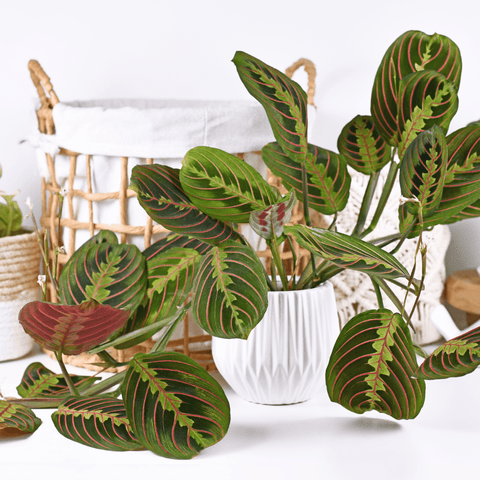Named for Bartolomeo Maranta, an Italian physician and botanist from the 16th century, the Maranta genus includes a few dozen low-growing plants native to Brazil, among them the renowned prayer plant (Maranta leuconeura). This plant gets its common name due to its leaves that remain flat during the day, then fold up like praying hands during the night.
The prayer plant is one of the most recognizable tropical species, renowned for its stunning decorative leaves. The popular tricolor variety features deep green, velvety leaves with yellow splotches along the midrib and vibrant red veins that run the length of its leaf margins. A slow-grower, the prayer plant can potentially reach up to a foot in height indoors. Consequently, they make popular houseplants and can be planted and cared for indoors during any season. However, they are not necessarily easy to keep for the long term.
Prayer plants and calatheas are so closely associated that it's not uncommon for them to be mislabeled. Of the many varieties of prayer plants, the most popular by far is the tricolor variation available at many garden centers. Within the Maranta genus, the following species are the most common:
M. leuconeura erythrophylla, also called the Herringbone Plant, features bold red veins and is the most common variety.
M. leuconeura kerchoveana, also known as Rabbit's Tracks, has plain green leaves with two rows of darker splotches.
M. leuconeura massangeana has a darker leaf background with silvery blotches along the midrib and white leaf veins.
Caring for a Maranta
Light
Position your prayer plant near a window where it can receive indirect sunlight. Avoid placing the plant in direct sunlight, which will scorch the leaves and cause discoloration. Prayer plants can also tolerate lower light areas; during the winter, when they become dormant or die back, they provide bright light.
Soil
Prayer plants can thrive in various soils as long as they are well-draining. A traditional potting mix usually works well, but you can also create your own mix by combining two parts sphagnum peat moss, one part loamy soil, and one part perlite or coarse sand. The soil should have an acidic pH of 6.0, and to improve drainage, add rocks or gravel to the bottom of the pot with ample drainage holes.
Water
During their growing season, water your prayer plant regularly (when the top layer dries out) and never let the soil completely dry. Prayer plants are very susceptible to drought; if left without water, the leaves will turn yellow and fall off. Use room temperature or slightly warm water when watering your prayer plant. Do not let water sit on the leaves, which can cause fungal problems.
Temperature and Humidity
Prayer plants prefer average household temperatures between 60 and 80 degrees Fahrenheit; prolonged lower temperatures can damage the leaves. These plants require very humid environments, so it is best to use a small humidifier. Mist the leaves with room temperature or slightly warm water to increase humidity.
Fertilizer
Feed your prayer plant every two weeks from early spring through fall (reducing to once a month in winter) with a water-soluble houseplant fertilizer diluted to half-strength. Too little fertilizer will cause slow growth, while too much can burn the roots, discolor the leaves and even kill the plant.





Comments (0)
There are no comments for this article. Be the first one to leave a message!